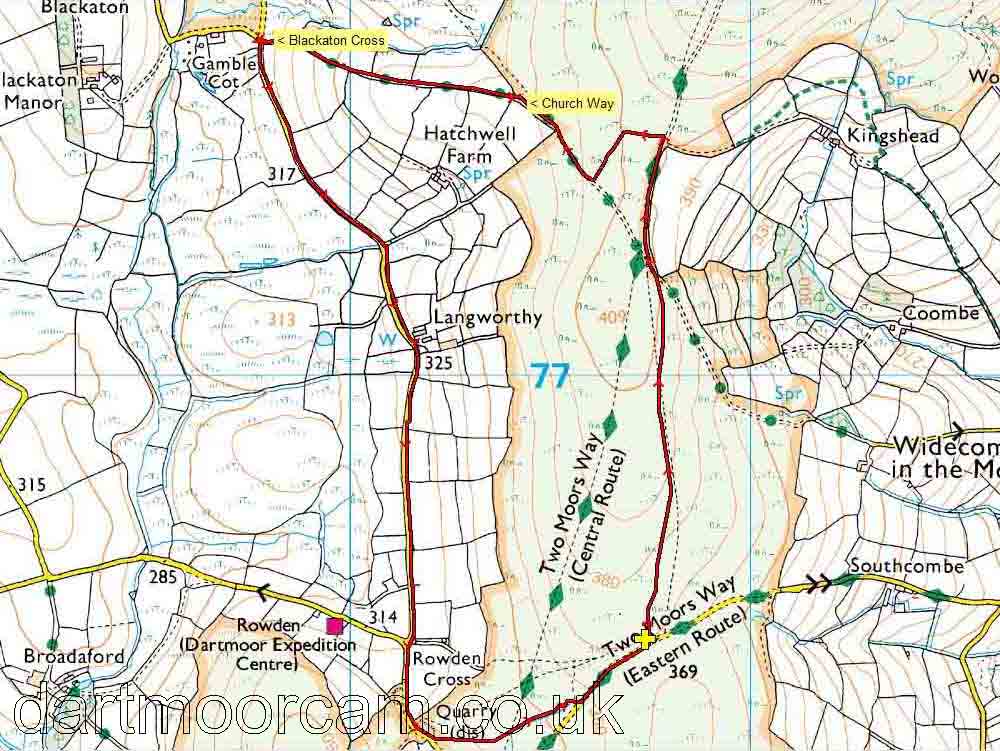


This walk: 2011-2-2. Two Crosses, Dunstone manor boundary stone, the Blue Stone (and the Grey Stone?), ponies, Church Way, cow, Blackaton Cross, Peltigera lichen, Harchwell sign, stone gate hanger, Langworthy Farm sign, white heather, sheep creep, Pennywort.
Walk details below - Information about the route etc.
From the Legendary Dartmoor web site "Two Crosses" page:
"It appears that a Mr R. Whale donated the stone which appears to have been previously used as a gatepost. The stone is to be placed at the point where the manors of Jordon, Blackslade, Dunstone and Widecombe town intersect. Always known as 'Two Crosses in the Turf' this location was always marked by two crosses cut into the turf, every year the village lengthsman would re-cut them to ensure of their visibility. In May 2008 the Widecombe History Group announced that the donated stone had been given to the Dartmoor National Park Authority to have the necessary engraving done. In June it seems the National Park's stonemason, Andy Cribbett was progressing well with the cutting of the stone and work was expected to be completed very soon. In July the long awaited announcement came that a ceremony was to be held on the 10th of July 2008 when the stone would be placed in-situ and all members of the Widecombe History Group were invited to attend."
The old Two Crosses stone (nearest the camera) with the new one directly in line behind it on the roadside, just by the bare earth.
The opposite side, showing nothing these days.
A Dunstone manor boundary stone at approx. 70745 72281 .....
A closer view of the inscribed "D", there was nothing else to be seen on the other three sides.
The noted "Blue Stone" - Two stones at approx. SX 707 775. The stone on the right is blue in colour: it is "Beside the Church Way at the corner of the Kingshead enclosures and is a large rounded boulder known as the Blue Stone � more often erroneously called Blue Post - a bond mark of Widecombe Town Manor. This is from Mike Brown�s �Guide to Dartmoor � CD. The blue colour might result from the stone actually being a blue granite - Blue Elvin. Granite can occur in a wide range of colours as shown by this web page that shows polished samples. Our guide is pointing out the less well-known Grey Stone.
The Blue Stone again.
Ponies with their rear ends into the wind and blowing rain - there is rain on the camera lens.
Even more rain on the camera lens, looking into the entrance to the Church Way at SX 70415 77691.
"This is the old church path that ran from the Pizwell and Runnage tenements to Widecombe church. This old track was regularly used by the inhabitants of the ancient tenement farms to get to church. Everything would come this way, churchgoers, coffins and funeral processions because Widecombe church was the nearest church. The first mention of the church way is in the Bailiff's account of the Forest manor in 1491. Prior to 1260 the holders of the tenements had to use Lydford church and would have to walk the Lych Way which was a trans moor route of some 12 miles. It was in 1260 that Bishop Branscombe gave leave for the tenement holders to use Widecombe church instead". Source: Legendary Dartmoor's Ephraim's Pinch web page.
A cow seen through a gate .....
Another view of the Church Way, running between two hadges.
Blackaton Cross.
A foliose lichen, meaning a leafy lichen that can be lifted away from its substrate and often attached by root-like hairs ("rhizines"). Identified as a Peltigera species, either P. horizontalis or P. latucifolia (the "lettuce lichen"). As there seems to be no real internet resource about P. latucifolia, my guess is that it is P. horizontalis although without putting it under a microscope, there are other close relatives: P. didactyla, P. hymenina (hymenina fruiting bodies are more orange?), P. membranacea, P. polydactylla & P. praetextata, all with with red fruiting bodies, and other Peltigera species without them. P. latucifolia and P. hymenina are synonyms for the same plant. The coloured fruiting areas (reddish-brown) are thin and are white underneath, occurring as upturned growths from the edge of the body of the lichen.
Another view .....
As previous photograph.
As previous photograph - the white rhizines ("rootlets") are clearly seen.
As previous photograph - to show the form of the thallus (i.e. the body of this "lower" plant).
Now here's a thing - a notched long stone - there must be a story to it? The right end appears to be shaped, but why>
Hatchwell Farm sign.
Moss covering (probably) hazel branches in the hedge .....
As previous photo.
"And this is a gate-hanger stone". A stone into which the upright ends of a gate would be fitted, one stone above and one below.
Langworthy Farm sign.
White heather - not sure if this is a white variety of Calluna vulgaris, Common Heather or Ling, or possibly Cassiope tetragona, Arctic bell heather.
A sheep creep in a wall, to allow sheep to pass through into the next field when it is uncovered.
An old lane leading to the ruins of an old building - see the low walls to the right, seen just before Rowden Cross on the map.
Wall pennywort, Umbilicus rupestris.
MAP: Red = GPS satellite track of the walk.

Ordnance Survey © Crown copyright 2005. All rights reserved. Licence number
100047373.
Also, Copyright © 2005, Memory-Map Europe, with permission.
This walk was accessed by turning west about 400 m south-west of the centre of Widecombe-n-the-Moor and climbing the hill to the car park (marked by the yellow cross) on the top of Dunstone Down.
Statistics
Distance - 5.31 km / 3.30 miles
All photographs on this web site are copyright ©2007-2016 Keith Ryan.
All rights reserved - please email for permissions